Anasa tristis
The squash bug is a pernicious insect, one of the most common and serious pests of cucurbit plants like squash and pumpkins, as well as cucumbers and melons, though typically to a lesser degree.
Unfortunately, these bugs are widespread throughout the US and southern Canada.
These insects can suck out a plant’s juices so aggressively that the plant will wilt and die, injecting toxic substances that only exacerbate the problem.
And if you didn’t think things could get any worse, squash bugs can infect your crops with cucurbit yellow vine disease (CYVD) as well.
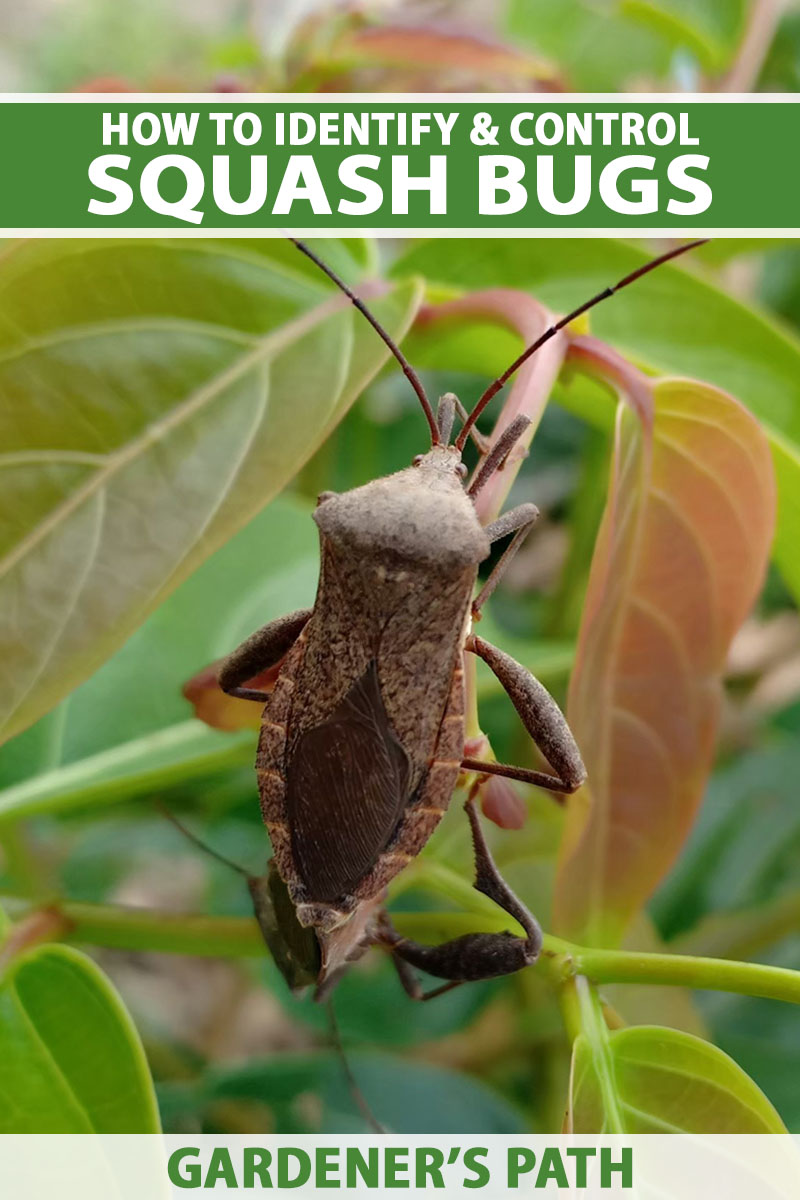
We link to vendors to help you find relevant products. If you buy from one of our links, we may earn a commission.
These insects are a particular problem with young plants, and those that are flowering.
What You’ll Learn
What Are Squash Bugs?
The symptoms of a squash bug infestation are sometimes mistaken for bacterial wilt.
When these pests feed, they cause yellow spots on the leaves that eventually turn brown. In severe infestations, the leaves can turn black and dry out.
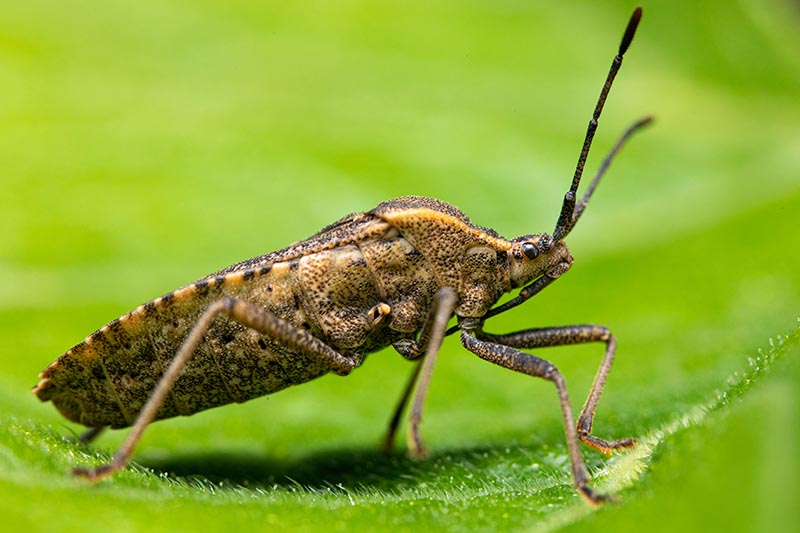
The damaged plants typically show signs of poor health as water stops flowing through them, but this is also due to the fact that toxic substances are injected into the leaves when the pests feed, causing what is sometimes referred to as anasa wilt.
Squash bugs will also feed on pumpkin fruit and hard winter squashes, though melons and cucumbers are rarely affected.
If this is the case, they produce two types of symptoms: dead, sunken areas that are readily colonized by the microbes that cause postharvest rots, and corky spots on the surface.
Identification
Female Anasa tristis adults typically appear in gardens in early June and lay their eggs through midsummer. In contrast to squash vine borers, they are usually much less of a problem with plants in the late summer and fall.
The adults are about five-eighths of an inch long, and dark gray to dark brown in color.
The colorful eggs are easy to spot. They start out orange-yellow and become bronze-colored just before hatching.
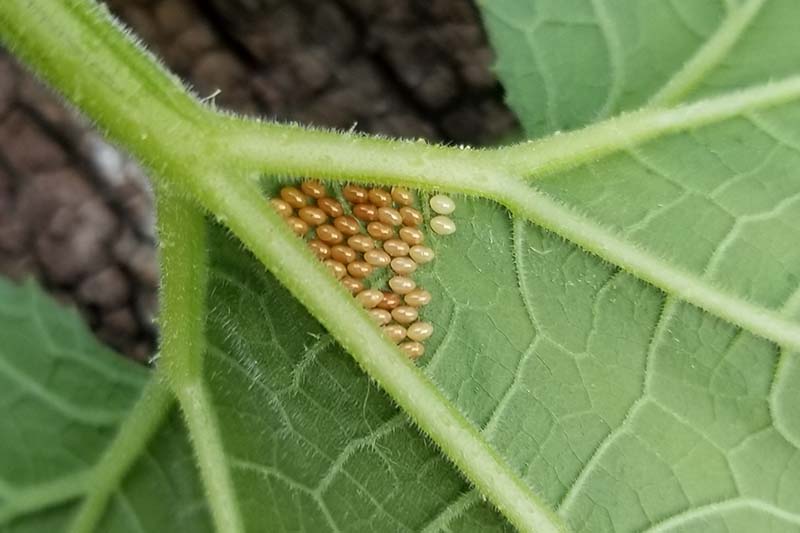
These oval-shaped eggs are about one-sixteenth of an inch long and laid in clusters of about 20 eggs. You will typically find them on the undersides of foliage between leaf veins where they form a V, and sometimes on stems as well.
Newly emerged nymphs are about one-tenth of an inch long and black with spindly legs, somewhat similar in appearance to spiders, at least from afar.
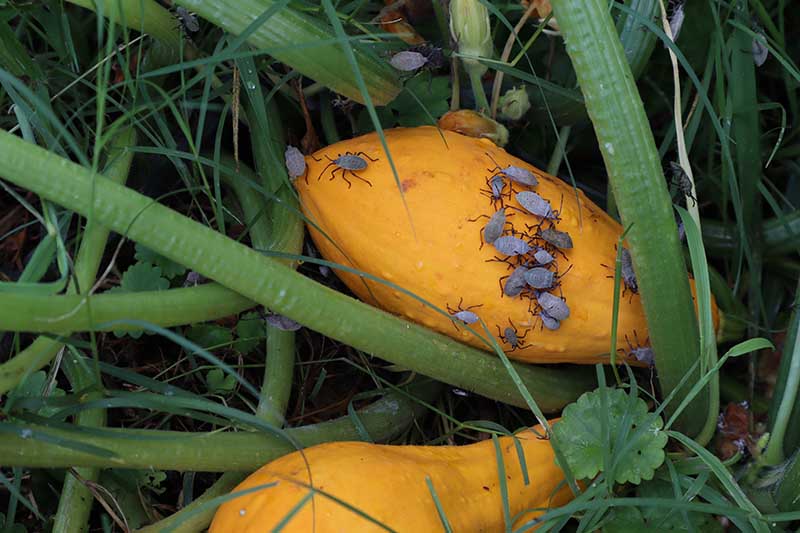
Light green with black heads and black or reddish legs in the next phase, and with a shape like bulbous and asymmetrical grains of rice, the maturing nymphs develop through five stages known as instars into elongated gray-brown shield-shaped adult insects that resemble stink bugs.
Both the adults and the nymphs will often be found hiding beneath foliage during the season. In the fall, after plants have died, you may see both adults and nymphs clustered on unpicked fruit.
Insects at various stages of the life cycle may be seen in the garden at the same time.
The adults suck – literally. They have piercing-sucking mouthparts that make them highly efficient at sucking the water and nutrients out of your plants, and they may transmit disease this way as well.
Other related species also known commonly as squash bugs may appear in the garden as well, though damage caused to crops by these pests is less typical. These include Anasa andresii, A. armigera, and A. scorbutica.
Biology and Life Cycle
Adult squash bugs survive the winter in sheltered places, such as under rocks, around buildings, and in plant debris.
Therefore, they are poised to strike when plants start growing in the spring, flying to cucurbit plants to feed and mate.
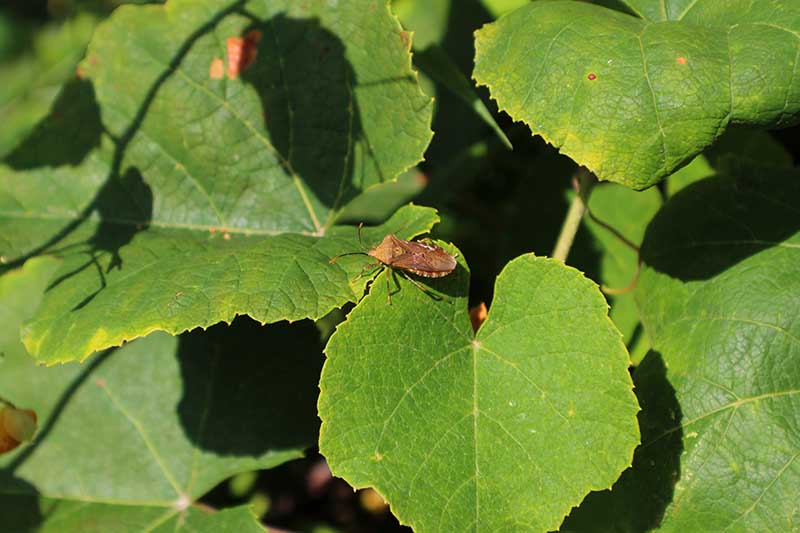
It is no surprise that these bugs are more likely to be a problem following a mild winter.
The eggs hatch in one to two weeks, and give rise to nymphs that mature about four to six weeks later, progressing through five instar stages.
These insects produce one generation per year in cooler parts of the country, such as Minnesota.
However, in other areas such as Kansas where it is warmer, the adults from the first generation may lay eggs for a second generation, and then these adults overwinter.
Immature nymphs will die off with the arrival of freezing temperatures, while adults will fly or crawl to shelter for overwintering before beginning the cycle again.
Serratia marcescens bacteria can overwinter in the bodies of the adult insects, which serve as vectors for cucurbit yellow vine disease. Chomping on leaves when they feed in the spring allows the transfer of the bacteria to your crops.
Monitoring
These insects tend to feed in groups, which makes them easy to spot.
One way to find out if they are in your garden is to put boards or shingles flat on the ground by the plants, and look under them the next morning. Squash bugs tend to congregate under flat surfaces during the night.
If the weather is extremely warm or cold, you might find the insects at the base of plants.
Check your plants daily if you can throughout the late spring and summer, and destroy any egg clusters or nymphs that you find.
Organic Control Methods
Keeping your cucurbits healthy will help to protect them against these pests.
Larger, sturdier plants are more likely to tolerate feeding damage that would kill young plants. But there are natural methods you can employ to provide extra protection.
Cultural Control
Since small plants and seedlings are more likely to be damaged significantly by squash bug feeding than more mature plants, consider using transplants instead of growing them from seed in your garden.
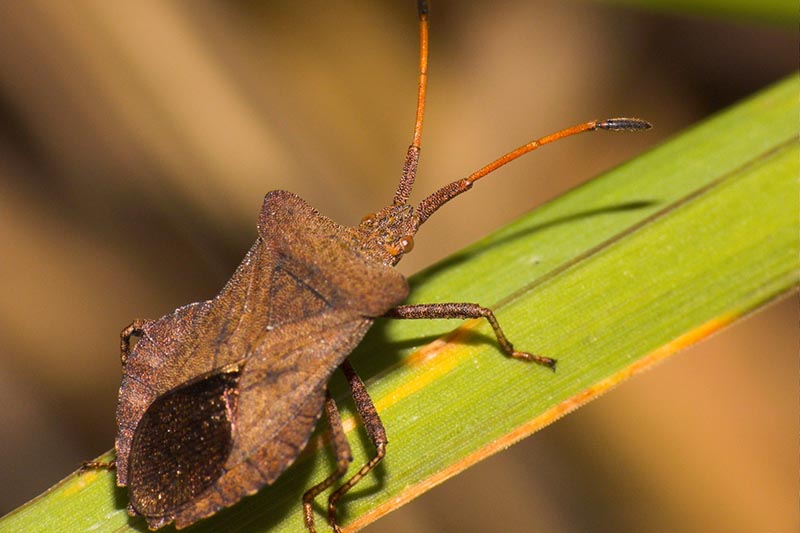
Keep in mind, however, that these pests prefer to feed and lay eggs on more mature plants.
Waiting to plant out your crops until seedlings are more mature means they will be less susceptible to damage, but this may not result in freeing them entirely from the risk of infestation.
Depending on your climate and the length of your growing season, planting short-season varieties that mature quickly may also help to avoid an infestation.
Be sure to check the number of days to maturity on seed packets for a given cultivar when making your selections.
More susceptible crops like zucchini and pumpkins may also be planted as a trap crop to keep the pests away from melons and cucumbers. This is often done in commercial operations.
Planting nasturtiums, on the other hand, can help to repel them.
It is critical to take appropriate measures after the harvest as well, to reduce populations of bugs that may overwinter in your vegetable garden.
Remove the fruit and foliage immediately after harvest, and work the soil if growing in the ground to reduce the presence of available hiding places.
Purging plant residue will tamp down any populations of nymphs and adults that are present. The nymphs will not have enough food to develop fully, and the adults will lack adequate nutrients to prepare them for overwintering.
The adult bugs fly in from elsewhere to mate and feed on your cucurbits before laying eggs, so crop rotation is not a failsafe way to prevent infestation. But it can help if you’ve had an infestation in the past.
Plant next year’s crop as far away from where you planted your cucurbits previously as you can, or use fresh soil in raised beds or containers.
Softer varieties of squash and other cucurbits tend to be more susceptible to feeding by these insects, with yellow summer squash often being the most vulnerable, and gourds and melons typically being less attractive.
Try to plant resistant varieties when available. These include ‘Butternut,’ ‘Early Summer Crookneck,’ ‘Green Striped Cushaw,’ ‘Improved Green Hubbard,’ ‘Spaghetti,’ and ‘Royal Acorn’ squash.
Physical and Biological Control
Growing your plants under floating row covers can protect them from infestation.
You will have to eventually remove the covers though, so that bees and other pollinators can pollinate the flowers.
Scouting for the bugs and destroying the nymphs and eggs early in the season, and continuing to do this throughout the growing season, will go a long way toward controlling these pests.
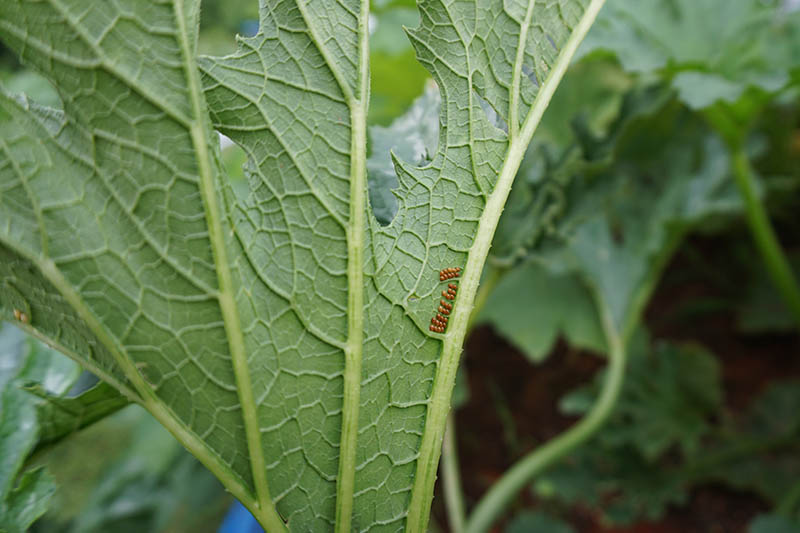
If only a few plants are infested, you can drop whatever bugs you find into soapy water, which will kill them.
But it can be surprisingly difficult to catch them, since these insects can move quickly and hide under leaves when disturbed.
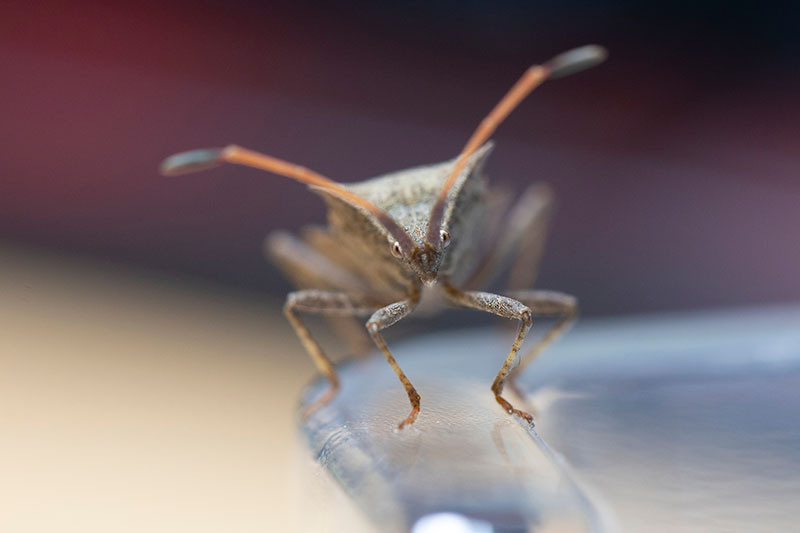
If you have put boards or shingles down as traps for monitoring, it’s easy to pick the insects off the bottom and destroy them.
Be vigilant throughout the growing season, and destroy any plant debris. This will reduce the available number of places where the bugs can hide.
Clear debris from around the base of your plants continually throughout the season, and clean up the garden well after the harvest too.
Unfortunately, mulch provides a good hiding place for these bugs.
In fact, the damage to plants that have been mulched can be more severe than it is for those grown in bare soil, according to Professor W. Cranshaw of Colorado State University.
Of course, biological systems are extremely complex, and there is a caveat to this no-mulch recommendation.
William E. Snyder, an entomology professor, debated the merits of straw mulch in an article on managing squash bugs in organic farming systems published by Washington State University. He explained that straw mulch encourages populations of ground beetles, which love to devour squash bug eggs.
While he noted the problems that mulches can incur, Dr. Snyder also pointed out that straw mulches help to control weeds, conserve water, and protect soil as well.
If you use straw mulch as a preventive measure, be sure to remove it at the end of the season.
And if you do choose to get rid of all the plant debris in your garden without putting down mulch, consider planting non-cucurbit cover crops instead, so the bare soil will not be vulnerable to erosion.
Adult tachinid flies will parasitize squash bugs, laying their eggs on the adult pests. When the larvae emerge, they feed on the insects. In addition to the aforementioned ground beetles, damselflies will feed on squash bug eggs as well.
Encourage beneficial insects to visit your garden by growing flowering plants nearby. Tachinid flies are also attracted to clover and wild carrot. Damselflies are attracted to ponds and streams.
Organic Pesticides
Ideally, if you have provided good cultural and physical controls in the spring, you will not have to resort to using insecticides. However, you may need to use them if you have a severe infestation.
If this is the case, concentrate your treatment at the base of the plants. Make your first application when you first detect the eggs, which will typically be in early summer. Treat again in a week or two.
If you have to spray later in the season, make sure to spray under the leaves, since that is where most of the pests will congregate.
Using diatomaceous earth and pyrethrins in combination can effectively kill these pests, and these treatments are certified organic. Neem oil is also recommended.
Spinosad is another option. But only some formulations of spinosad are organic, so if you require an organic treatment, you should check whether the one you’ve selected qualifies before buying it. Read labels carefully.
One formulation that is certified organic is Monterey Garden Insect Spray. It is available from Arbico Organics.
Chemical Pesticides
You can also use several types of chemical insecticides to treat severe infestations, including permethrin and esfenvalerate. Additional options include acetamiprid and malathion.
Spectracide Malathion Insect Spray Concentrate
You can buy Spectracide Malathion Insect Spray Concentrate from Tractor Supply Co.
Be sure to apply chemicals as directed in the garden, and only rely on this option as a last resort in cases of severe infestation.
Squash Those Bugs!
Alright, physically squashing them isn’t truly necessary if you have a bucket of soapy water at the ready.
But one of your best options in the fight against these pests is to remain vigilant, be on the lookout with daily monitoring of your plants, and do your best to remove eggs, nymphs, and adults by hand whenever you spot them.

Though insect pests are common in the garden, as long as you know what to look for, you should be able to enjoy a tasty harvest of squash or pumpkins nonetheless.
Have you struggled with a squash bug infestation in the garden? Have any questions? What worked for you? We’d love to hear from you in the comments below!
And for more information on growing healthy and delicious cucurbit plants, read these articles next:

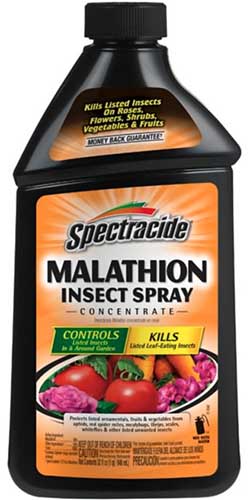
Thanks for the strategies to address these prolific and seemingly ubiquitous insects.
Can you treat your garden before planting with DE to help prevent infestation? I have had trouble with squash bugs in the past that killed all my plants. I also have trouble with a little yellow bug with black on it.
DE can be sprinkled on plants and the ground to address pests like squash bugs. But it must be reapplied often, particularly after rain. See our guide to diatomaceous earth for more info.